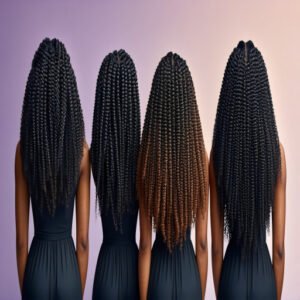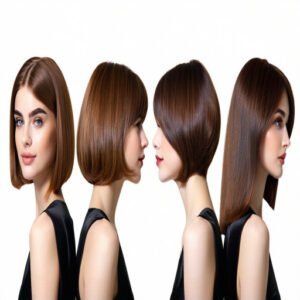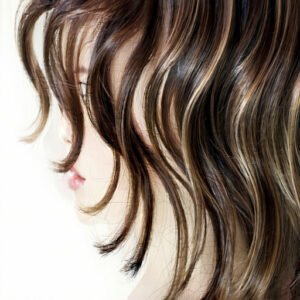This site is supported by our readers. We may earn a commission, at no cost to you, if you purchase through links.

Whether you’re rocking a sharp buzz cut, a sleek chin-length bob, or cascading tailbone tresses, the chart maps it all.
It also factors in hair texture—straight hair shows its full length, while curly or coily hair might surprise you with shrinkage (sometimes up to 75%).
Measuring from scalp to ends gives you the most accurate read.
Understanding these lengths helps you match styles to your vibe, face shape, and lifestyle.
Ready to explore your perfect match?
Table Of Contents
- Key Takeaways
- Understanding Hair Lengths
- Hair Length Charts Explained
- Hair Types and Length Perception
- Selecting The Right Hair Length
- Maintaining Desired Hair Length
- Frequently Asked Questions (FAQs)
- How to tell what hair length looks best on you?
- What is the most attractive hair length?
- What hair length makes you look younger?
- What length of hair is considered long?
- How does hair density impact hair length choice?
- Are specific hair lengths better for aging hair?
- Can hair length affect hair growth rate?
- Do seasonal changes influence optimal hair length?
- What’s the ideal hair length for active lifestyles?
- Conclusion
Key Takeaways
- Measure your hair from scalp to ends to track hair growth accurately, keeping in mind that curly and coily textures can shrink up to 75%.
- Use a hair length chart to match styles to your face shape, hair texture, and personal routine for the best look.
- Regular trims prevent split ends and keep your hair healthy, with shorter intervals for heat-styled hair and longer intervals for air-dried strands.
- Choose hair lengths based on your lifestyle, personality, and face shape, with mid-lengths offering versatility and long styles adding drama.
Understanding Hair Lengths
Regarding hair lengths, knowing where your hair falls—like chin-length, shoulder-length, or beyond—can make styling so much easier.
By understanding these categories and how to measure accurately, you’ll have a clear guide to achieve your perfect look.
Categories of Hair Length
Hair length categories range from super-short buzz cuts to flowy, waist-length locks, offering endless style variations.
A solid hair length guide can help you nail the perfect look, showing how length impacts style and vibe.
- Buzz Cuts: Low-maintenance and trendy.
- Chin-Length Bobs: Sleek, versatile everyday options.
- Shoulder-Length Shags: Perfect balance of playful and chic.
- Mid-Back Waves: Long enough for dramatic styles.
- Tailbone Tresses: Make a bold, breathtaking statement.
Importance of Accurate Measurement
Want to track your hair growth like a pro? Start with measurement tools for precision! A hair ruler or tape measure is perfect for achieving consistent results.
Follow these steps for accuracy:
- Use Measuring Techniques: Measure from the scalp to the ends, following the longest strand.
- Track Growth: Write down milestones for motivation.
- Check Texture Differences: Straight, curly, or wavy? Your hair length chart shows how textures change perceived length.
Understanding your hair length chart is important for accurate hair growth tracking and maintenance.
Hair Length Charts Explained
Choosing a new haircut shouldn’t feel like guessing the plot of a mystery novel.
This is where a detailed hair length chart swoops in to save the day.
It’s like having a cheat sheet for showing exactly where each hair length falls, so you’re not left saying, “Wait, that’s shorter than I thought!”
Whether you’re planning a pixie cut or aiming for flowing, waist-length waves, these charts are your go-to measurement tool.
Plus, they account for length variations based on your hair’s texture—straight, wavy, curly, or kinky-coily—because let’s be honest, curly hair never looks as long as it really is.
Use this as a guide to measure hair length and match it to styles that fit your vibe.
Here’s a quick chart example to help:
| Hair Length | Example Styles | Ideal For Face Shapes |
|---|---|---|
| Short (Pixie, Bob) |
A solid hair length guide keeps you confident, clear, and ready for your next salon visit!
Hair Types and Length Perception
Your hair type plays a huge role in how its length looks, especially when comparing straight, wavy, or curly textures.
Curly and coily hair can look much shorter than it actually is, so keeping shrinkage in mind helps when choosing or measuring your ideal length.
Straight Vs. Curly Hair
Your hair’s journey from straight to curly creates unique length illusions worth understanding.
Straight hair gives you a true-to-length look, while curly hair can shrink up to 75% shorter than its actual length.
This length distortion means your curl patterns need different styling tips than straight locks.
To accurately determine your hair length, consider using the body marker method for a more visual approach.
When measuring, remember that hair shrinkage plays a big role – what looks like shoulder-length curly hair might actually reach mid-back when straightened.
A hair length chart can help you understand these differences.
Impact of Hair Texture
Think of hair texture like a spring – the tighter the coils, the more your true length plays hide and seek.
While straight hair hangs predictably, different texture types tell their own story on the hair length chart. A curl pattern analysis reveals why your bestie’s shoulder-length cut might look totally different on you.
A wide variety of hair texture products are available to help manage and define your unique curl pattern.
Here’s what impacts how your length shows up:
- Hair porosity affects how your strands respond to moisture, making them appear shorter or longer
- Natural curl patterns can shrink your visible length by up to 75%
- Hair elasticity determines whether your locks stretch or snap when pulled
- Texture analysis helps predict how much length you’ll lose to waves or coils
- Frizz control products can help showcase your true length by smoothing the cuticle
Remember, measuring your hair when both wet and dry gives you the full picture of your length story.
Selecting The Right Hair Length
You’ll find it easier to pick your perfect hair length when you match it to both your face shape and daily routine, whether you’re dreaming of a pixie cut or flowing locks.
If you’re stuck between a chin-length bob or shoulder-length waves, we’ll help you figure out which length will make you look and feel your best.
Considering Lifestyle and Personality
Hair length choices tell a story about who you’re and how you spend your days.
If you’re always on the move, a shorter style might match your daily routine better – it’s quick to style and low maintenance.
Your personal style shines through longer locks if you enjoy experimenting with different looks. To find the perfect style, consider checking a hair length chart for guidance.
Career impact matters too – some jobs need more polished styles. Whatever length you choose, it’s about finding what fits your lifestyle and lets you express yourself naturally.
Matching Hair Length to Face Shape
Your face shape tells quite a story about which hair length will make you shine.
Just like picking the perfect frame for a photo, choosing the right length brings out your best features. Oblong faces benefit from hairstyles that add width, such as textured crops or pompadours, as discussed in this oblong face guide.
- Oval faces rock any length, but layered cuts really make those features pop
- Round faces glow with longer styles that slim and elongate
- Square faces soften beautifully with waves falling past the jaw
- Heart-shaped faces balance perfectly with shoulder-grazing cuts
- Diamond faces dazzle with textured lobs that highlight those amazing cheekbones
Maintaining Desired Hair Length
You’ll need more than just patience to maintain your dream hair length, from regular trims to proper care routines that match your hair type.
Whether you’re rocking a sleek bob or aiming for mermaid-length locks, you’ll find that keeping your desired length is all about knowing when to trim and how to protect your hair from damage.
Care Tips for Different Lengths
Got a style in mind? Keep it fresh with the right care for every length.
Short cuts love a lightweight touch—use texturizers and sleep on silk pillowcases to banish bedhead.
Medium locks? Hydration’s your sidekick, with weekly deep conditioning treatments to keep strands happy.
Long hair needs extra TLC—detangle gently, shampoo smart, and protect those ends with regular trims.
To achieve ideal hair health, consider following simple hair growth tips. Switch up your product selection each season for healthier strands, and remember: great hair’s all about finding what works for you!
When to Trim
Trimming your hair isn’t just a chore—it’s essential for keeping your locks healthy and vibrant.
When split ends creep in or your style looks limp, it’s time to grab those scissors. Think of it as your hair’s reboot button, resetting for better growth and less breakage.
Using the right hair trimming tools can make a significant difference in the quality of your trim.
- Watch for split ends or dry, crunchy tips.
- Notice tangles or stubborn frizz.
- Heat styling? Trim every 4 weeks.
- Air-drying? Stretch trims to 12 weeks.
- Stick to regular trims for ideal hair length and shape.
Frequently Asked Questions (FAQs)
How to tell what hair length looks best on you?
You know that awkward mirror moment where nothing feels right?
Face shape, hair texture, and personal style matter most.
Experiment with clip-ins, fake bobs, or length charts to find what truly highlights your vibe.
What is the most attractive hair length?
The most attractive hair length is the one that makes you feel amazing.
Shoulder-length works for versatility, while long hair offers drama.
Short cuts, like pixies, highlight bold features. Confidence sells any length better than perfection!
What hair length makes you look younger?
Chopping off extra inches can work wonders.
A chin-length bob or layered shoulder-length cut frames your face, softens features, and adds movement.
Making you look fresh, vibrant, and a few years younger instantly.
What length of hair is considered long?
Long hair usually starts around mid-back, where it flows past your shoulder blades.
It’s the kind of length that’s hard to miss, giving you tons of styling options—from braids to dramatic waves.
How does hair density impact hair length choice?
Hair density plays a huge role in choosing length.
Thicker hair supports longer styles, adding volume, while thin hair can appear limp if grown too long.
Medium lengths, like bobs, often work best for finer hair types.
Are specific hair lengths better for aging hair?
Aging hair needs some TLC.
Mid-length styles like shoulder-length bobs or shags can help thinning hair look fuller.
Shorter cuts reduce weight and breakage, and layers add volume, and bangs soften fine lines beautifully.
Can hair length affect hair growth rate?
Your hair length doesn’t actually change how fast it grows—growth happens at the roots.
However, longer hair needs extra care to avoid breakage or split ends, making it appear like it’s growing slower.
Do seasonal changes influence optimal hair length?
Over 50% of people notice seasonal changes affect hair care routines.
Winter’s dryness demands shorter, low-maintenance trims, while summer’s heat inspires breezier styles like bobs or lobs.
Adapt your length to fit the season’s vibe comfortably!
What’s the ideal hair length for active lifestyles?
Go for chin-to-shoulder length—it’s versatile, low-maintenance, and stays out of your face during workouts.
Styles like bobs or ponytails work great and won’t slow you down whether you’re hiking, running, or hitting the gym.
Conclusion
Ready to switch things up with your look?
A hair length chart is your cheat sheet to finding the perfect style, whether you’re aiming for bold pixie cuts or long, flowing locks.
It helps you zero in on lengths that match your face shape, style, and routine.
Don’t forget, hair texture changes the game—curly girls, watch for shrinkage!
With the right length, plus some TLC for maintenance, you’re set to slay every single day.








